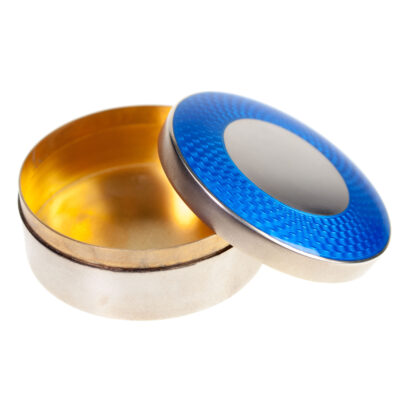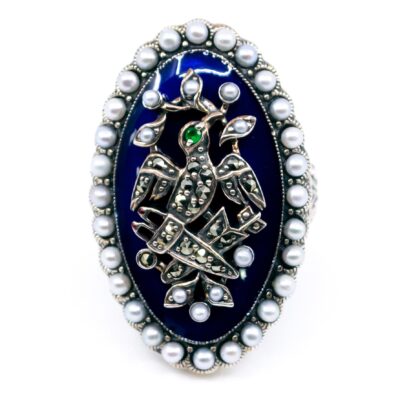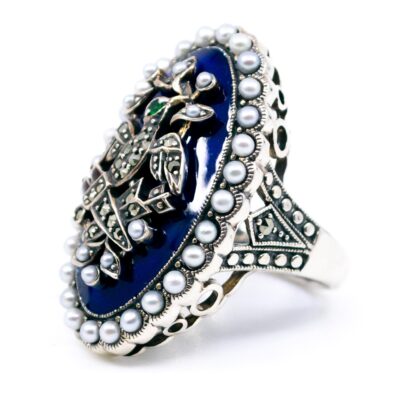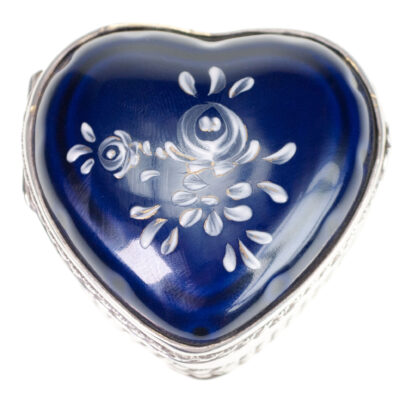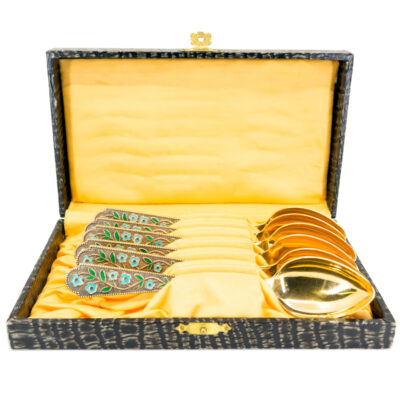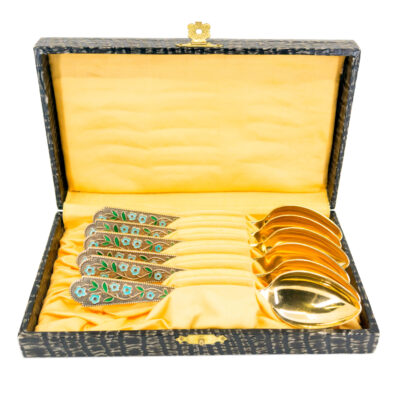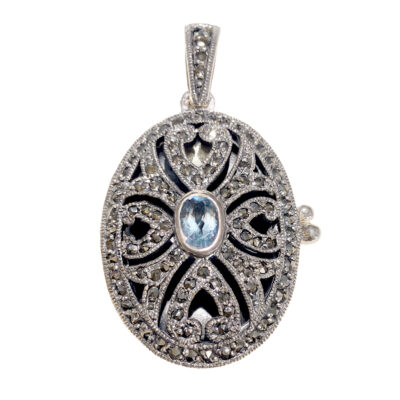Imagine elegant gatherings where laughter filled the air and this napkin ring graced the table. ✨ This vintage gem, crafted in 1946 London silver, carries the echoes of those moments. Its intriguing green flag and playful lizard invite conversation and spark curiosity. A unique piece to add a touch of history and personality to your table.
Imagine elegant gatherings where laughter filled the air and this napkin ring graced the table. ✨ This vintage gem, crafted in 1946 London silver, carries the echoes of those moments. Its intriguing green flag and playful lizard invite conversation and spark curiosity. A unique piece to add a touch of history and personality to your table.
Details: Enamel, Silver Napkin Ring
Dimensions: H 3 x W 5 cm.
Weight in grams: 31.
Condition: Very good condition – slightly used with small signs of wear.
| Design Era | |
|---|---|
| Design & Historical Context | The jewelry industry was significantly impacted by the onset of World War II in the 1940s. Precious metals, particularly platinum, became scarce and in some cases were even banned from being sold. Palladium was used as a substitute for platinum in the war effort. In order to make the most of the limited supply of gold, a low karat gold alloy with a higher percentage of copper was used. This resulted in gold with a subtle, reddish hue, but through the use of different alloys, gold was able to appear in a range of colors within a single piece. Gold was also manipulated in various ways, such as being woven, braided, and coiled. Techniques like resilla, cannetille, and lacy filigree patterns reappeared in jewelry. Different textures were also used within a single design, with matte finishes being placed next to bright finishes to accentuate the design. Gold became the primary metal used in jewelry during the 1940s and 1950s. |
| Key Materials | |
| Materials & Craftsmanship | Silver: The Metal of Elegance and Versatility Silver, known for its bright, reflective luster, is one of the most beloved and widely used precious metals in the world. This versatile metal has been cherished for thousands of years, not only for its beauty but also for its malleability, making it ideal for crafting intricate and delicate jewelry designs. Historically, silver has been associated with the moon and considered a symbol of purity, clarity, and protection. Ancient civilizations, from the Egyptians to the Greeks and Romans, valued silver for its beauty and used it to create coins, jewelry, and religious artifacts. In many cultures, silver is also believed to have healing properties, often used in amulets and talismans to ward off negative energy. In modern jewelry, silver is prized for its affordability, versatility, and timeless appeal. Sterling silver, an alloy of 92.5% pure silver and 7.5% other metals (usually copper), is the standard used in high-quality jewelry. Its durability and bright, reflective surface make it an excellent choice for a wide range of designs, from minimalist pieces to ornate creations. Silver can be polished to a high shine or given a matte, oxidized, or antiqued finish to suit various styles. Silver is more than just a metal; it is a symbol of elegance, flexibility, and understated luxury. Its enduring popularity and wide-ranging applications make it a staple in jewelry that can complement any look, from casual to formal, with timeless grace. Enamel: The Artful Fusion of Color and Craftsmanship Enamel is a decorative technique that has been used in jewelry for centuries, known for its ability to bring vibrant color and intricate designs to metal surfaces. Created by fusing powdered glass to metal at high temperatures, enamel can produce a wide range of colors, from bold and opaque to translucent and delicate. Historically, enamel has been used across various cultures, from ancient Egypt and China to Renaissance Europe, to create stunning works of art in jewelry, religious artifacts, and decorative objects. The intricate process of enameling, which requires skill and precision, has made it a prized technique among artisans. In contemporary jewelry, enamel is appreciated for its versatility and ability to enhance the beauty of metalwork. It can be used to add a pop of color to a piece, create detailed imagery, or produce a smooth, glossy finish that complements gemstones and precious metals. Enamel not only adds a burst of color and creativity to jewelry but also represents the craftsmanship and artistry behind each piece. Whether in modern or vintage designs, enamel brings a unique and timeless appeal to jewelry, making it a cherished choice for those who appreciate fine detail and vibrant hues. |
| Dimensions | H 3 x W 5 cm |
| Gender | |
| Weight (in grams) | 31 |
| Condition | Very good condition – slightly used with small signs of wear |
By following these tips, you can enjoy your precious jewelry for many years to come.
Related Products
-
Enamel Silver Silver-Gilt Guilloche Box 1427-1904
€ 795,00 VAT incl. (where applicable) -
Emerald Enamel Marcasite (Pyrite) Pearl Silver Figural Ring 14182-1517
€ 375,00 VAT incl. (where applicable) -
Enamel Porcelain Silver Heart-Shape Box 827-0841
€ 595,00 VAT incl. (where applicable) -
Enamel Silver Cloissoné Spoon Set 11790-2853
€ 995,00 VAT incl. (where applicable) -
Enamel Silver Salt Cellar And Condiment Bowl Condiments 3451-2023
€ 495,00 VAT incl. (where applicable) -
Enamel Silver “Doctor” Figurine 15714-3119
€ 1.695,00 VAT incl. (where applicable) -
Marcasite (Pyrite) Topaz Silver Oval-Shape Locket 18412-3475
€ 245,00 VAT incl. (where applicable) -
Enamel Pearl Ruby 925′ Silver Butterfly Brooch 18266-3409
€ 265,00 VAT incl. (where applicable)
- Home
- Collection
- Fine Jewelry
- Silver Jewelry
- Silverware
- Boxes
- Candlesticks
- Salt and pepper shakers
- Miniatures
- Salt cellars
- Spoon Set
- Condiments
- Frames
- Napkin Ring
- Spoon
- Oddities
- Cups
- Vases
- Cutlery
- Serving Spoon And Cake Server
- Candlesticks
- Baskets
- Hanukkiah
- Spice Tower
- Yad
- Tea Set
- Sugar Castor
- Napkin Rings
- Wine Bottle Coaster
- Wine Stopper
- Tea Pot
- Jugs
- Rattles
- Hip Flask
- Miscellaneous
- Rings 💍
- About
- Contact



